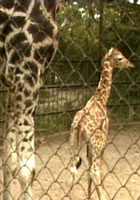 |
|
|
Baby giraffe brings joy to zoo Kolkata: Birth of a giraffe at a zoo in India's eastern Kolkota city has brought joy to the inmates. Born to mother Uttara and father Roshan, the baby is seventh giraffe in the zoo. The 12-foot tall giraffe is being fed on melons and milk and will be named later this month. Zoo officials said a special cage has been made for the baby as he has to be protected from overhead electric wires and trees. "Now, at the Alipore zoo, there are seven giraffes including this one. Uttara, the female and mother of the new born baby, was brought from Germany and the father, Roshan, was born here in Alipore," said Dr S K Choudhury, Director, Alipore Zoological Gardens.
The
visitors to the zoo old and young alike were awestruck by the sight
of the baby giraffe. Large crowds gathered outside the giraffe enclosure
throughout the day to view the mother and child. "We liked it very much.
The baby giraffe is very beautiful. We, being parents can understand
seeing the baby giraffe, what is like to have a baby," said Ashim Kumar
Ghoshal, a visitor.
The
giraffes are kept on a special diet which includes water melons, apple,
paste of rice and sugar and boiled water. The giraffe is a shy, quite
and mild animal inhabiting south of Sahara desert in Africa. Their height
varies from three to four metres and weigh 550 to 1,800 kg. Theyare
gregarious and wander in herds. They can run up to a maximum speed of
45 km per hour. They feed mainly on leaves and seasonal fruits and can
live without water for weeks. The breeding season is from July to September.
Usually one baby is born after a gestation period of 420 to 459 days.
They mature at the age of three to four years and their life span is
usually 15 to 20 years. Eco-tourism in Sikkim (Go to Top) Gangtok: Sikkim has been chosen by UNESCO as one of the sites for developing eco-tourism. This initiative is being worked out in collaboration with the Seattle-based Environment Coalition of South or ECOSS and Sikkim's village communities. Nestled in the Eastern Himalayas, the state of Sikkim in India is home to immense biological diversity and a rich cultural heritage. Sikkim comprises only .2 percent of the total geographical area of the country; it however, has around twenty five percent of the flowering plants of India. The rugged topography is not conducive to efficient agricultural practices but provides a wonderful opportunity for the development of tourism. Eco tourism is designed to help conserve Sikkim's natural resources and to develop economic livelihood opportunities. At the heart of the project are innovative participatory approaches that strengthen the capacities of local communities to conserve Sikkim's unique natural and cultural heritage. "We are basically working with community based organizations to strengthen the skills and capacities to manage tourism in a more responsible manner. Many communities, who are in Sikkim, are very keen to promote village tourism. So many aspects of village tourism need to be covered when we develop certain products. So in various districts of Sikkim, north Sikkim, we have got a small projects in collaboration with eco tourism community," says Regina Lepcha, Member, Environment Coalition of South Seattle. Villagers themselves have come forward to actively participate in the project. Village community leaders act as guide and help the tourists get a better understanding of local culture. Now an attempt is being made to network all the four hundred and fifty two villages of the state for marketing village tourism in a big way. All the stakeholders, like villagers and community-based organizations, will share the benefit accruing from the project. Many domestic and international tourists visit Sikkim. They can now experience authentic village lifestyle and at the same time enjoy modern facilities in rural settings. Ecotourism, with its focus on environmentally sound practices and generating widespread economic incentives to conserve, offers a great opportunity for Sikkim to improve livelihoods and to protect its unique heritage. "Future
prospects of village tourism is just now the different products are
being developed. Villages are trying and testing it out. And in the
near future we would like to see how these village tourism sites can
be networked. And how visitors come not only on site but how it is networked
across several different sites. This is just initial phase; we plan
to work with many different communities all over Sikkim. And only network
within Sikkim only but also outside Sikkim. Right standing from Laddakh,
Uttaranchal, Himachal across north east India also," Lepcha adds. This
attempt is paying rich dividends. Sikkim has registered a thirty percent
growth in tourist inflow this year, beating the record of the last three
years. The tourist officials say that ecotourism has a significant presence
in Sikkim today and will be a key contributor to sustainable tourism
development efforts in the state in the future.
References: Giraffe Alipore
zoo, India, India News, Newspaper, Indian, News, Travel News, India
Travel Times, Travel,Tourism, Tour, Tourist, India, Times, News, Hotels,
Airlines, Ayurveda, Yoga, Hindu, Taj Mahal, Cuisine, Festival, Temple,
Trekking, Hindu, Bharatanatyam, Kathakali, Odissi, Dance, Shimla,Varanasi,
Kullu, Manali, Dehra Dun, Mussourie, Mussoorie, Haridwar, Hardwar, Rishikesh,
Nainital, Delhi, Goa, Kovalam, Darjeeling, Bodh Gaya, Kancheepuram,
Kanchipuram, Thekkady, Badrinath, Amar Nath,Vaishno Devi, Tirupati,
Sabarimala, Guruvayoor, Kanyakumari, Kodaikanal, Ooty, Chennai,
|
Home
Contact Us
NOTE:
Free contributions of articles
and reports may be sent to editor@indiatraveltimes.com
DISCLAIMER
All Rights Reserved ©indiatraveltimes.com
